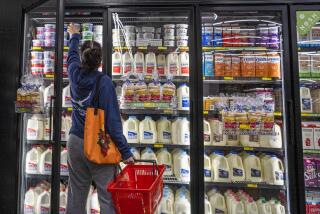Core U.S. Producer Prices Rise 0.1%
- Share via
U.S. producer prices excluding volatile energy and food costs inched up 0.1% last month, easing inflation fears, while housing starts tumbled, though weather may have slowed new construction.
The overall producer price index, a gauge of prices received by farms, factories and refineries, shot up 0.7% in March, the Labor Department said Tuesday. It was the largest gain since an energy-led increase in November.
But outside of food and energy costs, producer prices advanced a mild 0.1% for the second straight month.
Also Tuesday, the Commerce Department said housing starts plunged 17.6% in March, their biggest drop since January 1991, to a 1.84-million-unit rate from an upwardly revised 2.23-million-unit pace in February.
Wall Street economists had expected housing starts to slip a far smaller 4.8%, and many blamed poor weather for the worse-than-expected showing. The producer price report, in contrast, came in close to forecasts.
“The housing data are further evidence of a loss of momentum in the economic expansion but [present] no genuine threat of an outright slowdown,” Roger Kubarych, senior economic advisor at HVB Bank, said in a research note.
Energy prices shot up 3.3% in March, the biggest jump since October, with gasoline prices up 5.3%, home heating oil up 15.7% and residential natural gas up 2.3%. Food prices advanced 0.3%.
Over the last 12 months, producer prices have risen a sharp 4.9% -- the biggest year-on-year gain since November -- as oil prices have pushed higher.
The cost of business capital equipment contributed to the pickup in overall producer prices, rising 0.3% -- a turnaround from a February drop. But prices for non-energy consumer goods edged up just 0.1%.
Prices for cars, light trucks and SUVs slipped 0.2% last month, the second consecutive monthly drop, and the cost of computers plunged 3.4%.
The housing starts report showed widespread weakness, with groundbreaking activity for both single-family and multifamily homes tumbling and activity off across the nation.
In recent weeks, several U.S. home builders have reported construction delays because of severe weather.
Ryland Group Inc. and MDC Holdings Inc. were among those that have said weather-related delays in red-hot markets would push home closings into later quarters.
Single-family starts slid 14.4%, the largest drop since January 1991, and starts on structures with five or more units fell 31.6%, the biggest drop since March 2000.
Permits for future groundbreaking, an indicator of builder confidence, also fell more than expected but remained at a level economists said showed some fundamental strength.
More to Read
Inside the business of entertainment
The Wide Shot brings you news, analysis and insights on everything from streaming wars to production — and what it all means for the future.
You may occasionally receive promotional content from the Los Angeles Times.










